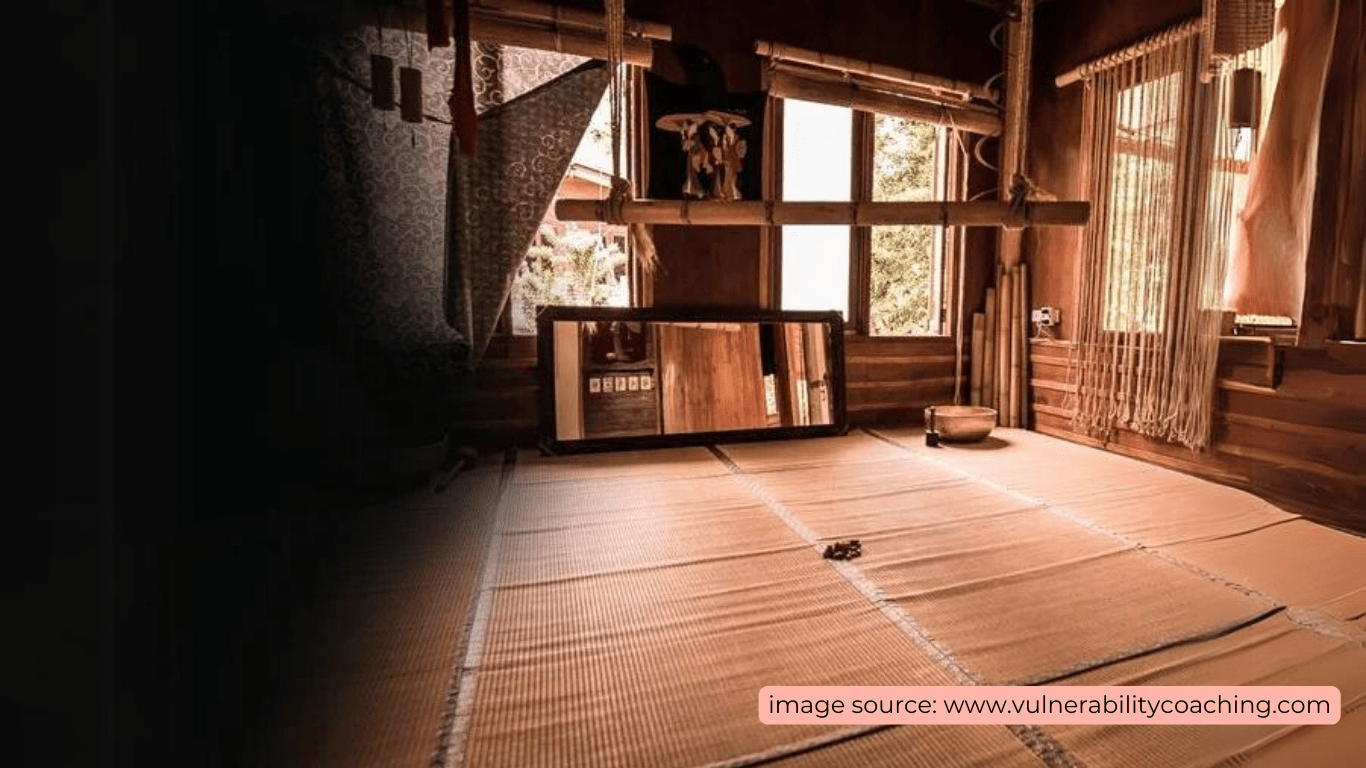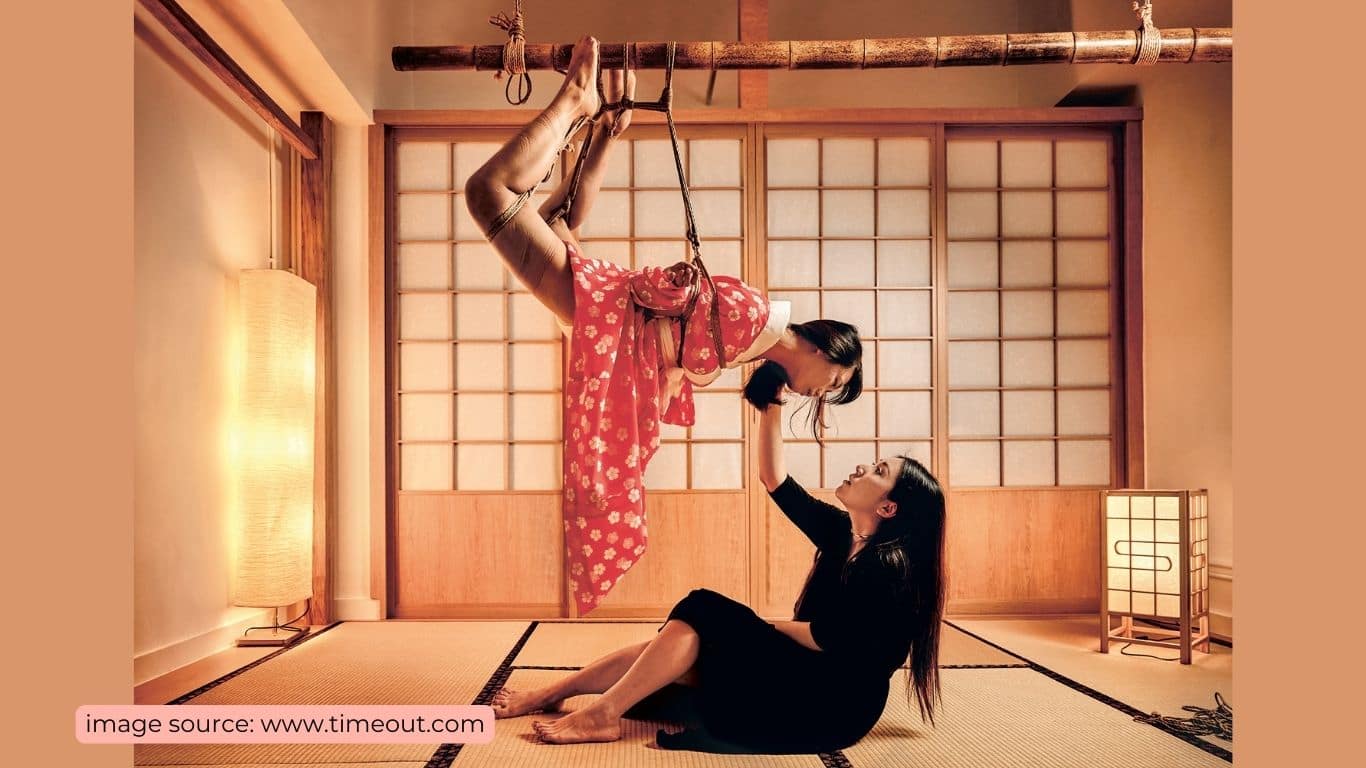Shibari, sometimes referred to as Kinbaku, is a centuries-old form of rope bondage practiced in Japan. “Shibari” literally means “to bind” in Japanese. It began between 1400-1700 AD as a martial technique known as hojojutsu and was employed by samurai to restrain their captives.
Through Kabuki theater, rope bondage evolved from its martial arts roots to a form of entertainment during the Edo era (1603–1867 AD). To improve the overall visual appeal of the show, performers created a variety of stances and motions on stage through dramatic displays of shackles employing rope bondage. This can be seen as the start of shibari as we know it today, and with time, the craft, sensuality, and erotic elements of Shibari started to emerge. Even though Shibari is often seen as a subset of BDSM in a broader sense, I believe that anyone—regardless of whether they consider themselves kinky—can practice it, as long as they prioritize consent and safety, which are typically associated with kink.
This website created by one of my friends has a lot of information on Shibari.
Using both my personal experiences and recent studies, I hope to explore the spiritual and therapeutic components of Shibari in this post.
Warning: This post is not a how-to guide on Shibari. Without the requisite knowledge and experience, practicing Shibari can result in potentially serious injuries. It is best to seek out safe communities and people in your area to learn from and practice Shibari with.

Understanding the Healing and Transformative Power of Shibari
Shibari could mean many things to different people, but to me, it’s all about experiencing a unique blend of sensual pleasure, emotional release, and some spiritual elements. Its healing power comes from willingly surrendering to the ropes, the person tying them (the rigger), and the present moment, all built on complete trust. A normal Shibari session starts with the rigger and the bunny (the person being tied) having an open dialogue in which they set boundaries, obtain consent, and create a safe, respectful and comfortable space for one another.
As the rigger gently wraps the bunny’s body in rope, adjusting tension and playing with friction to balance roughness, softness, and sensuality, a profound sense of submission begins to unfold. As one of the studies (discussed later) participants beautifully put it, “to be in control of not being in control is empowering,” and this act of giving up control results in a profound sense of liberation. The tactile sensations produced by the ropes create a beautiful blend of discomfort and pleasure. This lets the bunny to completely give up control, allowing the ropes to wrap around their body and stay fully present in the moment. They could give in to the physical adventure as the rigger guides them into different positions, testing their flexibility and boundaries.
In scenarios involving suspension, the body hangs freely, adding an enticing element that deepens the bunny’s sense of surrender. Adding things like blindfolds or ear plugs to restrict their hearing enhances the sensory experience, bringing the bunny even closer to the present moment. In this state, a sense of deep calmness envelops the mind, allowing the bunny to fully focus on and savor all the subtle sensations in their body. It might even bring about entirely new experiences.
This consensual surrender through Shibari brings a profound sense of liberation, leading to deep relaxation. Like many mindfulness practices, Shibari helps its practitioner to develop present-moment awareness, which allows for heightened sensations and an all-encompassing connection to their body. This offers a path to spiritual growth because it creates a deep sense of unity both with their surroundings and with themselves. Shibari is known for this heightened experiences, both physical and spiritual. One of the most common experiences is a sense of weightlessness, which is similar to leaving the physical world behind and entering a higher spiritual state. The bunny is able to detach from outside distractions and enter a profoundly spiritual experience through this inward journey.

Contemporary Research on Healing Through Shibari
Though there’s not much peer-reviewed research on the healing and spiritual sides of Shibari, several phenomenological studies offer valuable insights into participants’ journeys of healing and spiritual growth. For instance, Eva Harris, who holds a Master of Science in Consciousness, Spirituality, and Transpersonal Psychology, conducted a study titled “Healing Experiences in Japanese Rope Bondage Practice: A Phenomenological Study.” Mirabai Galati, a researcher in Medical Anthropology, conducted another study titled “The Therapeutic Impact of Rope Bondage: A Case Study.” All these research sheds light on the many healing experiences reported by Shibari practitioners. Some participants even acknowledged that Shibari acts as a gateway to their spirituality.
Thomas R. Egnew, a well-known figure in healing and medicine, defines true healing as the journey toward wholeness. In his article “The Meaning of Healing: Transcending Suffering,” he discusses holistic health, which includes physical, spiritual, emotional, social, and psychosocial aspects. As mindfulness and self-awareness techniques gain popularity today, I strongly feel that the idea of healing increasingly aligns with Egnew’s holistic well-being approach.
Shibari, defined as a process that involves physical, spiritual, and emotional dimensions, has been demonstrated to improve overall well-being and personal growth by connecting practitioners to their emotional, mental, and spiritual aspects. For example, some research participants talked about the significant impact rope bondage had on their emotions, feelings, self-perceptions and even self-image. Many participants shared how Shibari gave them a safe space to let go of their past sexual trauma and experience a cathartic release. Sexual assault survivors who practice Shibari reported higher self-acceptance, rediscovering their joy, and regaining their sense of agency and control. Similarly, practicing Shibari has helped many people, including myself, find more self-love and acceptance despite struggles with body image issues.
A participant in Galati’s study succinctly summarized a theme that appeared repeatedly in the researches: “It is empowering to be in control of not being in control.” I can really relate to this feeling. Given that they can end the session at any time, giving them total agency and control over the session and their experiences, it represents the freedom and sense of safety a rope bunny feels during the Shibari session. Personally, it’s this combination of surrender and control that takes Shibari to a spiritual level. It’s about choosing to let go and finding strength in your vulnerability, which is a profound journey of self-discovery. By navigating these emotions and experiences, you experience personal transformation and gain a greater understanding of yourself. Isn’t that what we’re all aiming for when we meditate or engage in other self-awareness practices? In the end, we’re all searching for that deep inner connection that lets us explore our inner selves and grow from within.
Personal Experiences with Shibari
Shibari has been an incredibly transformative journey for me. It has always been more than just pretty ties, technicalities and pictures; it’s a deeply enriching and nurturing experience that resonates with me on both physical and spiritual levels.
I clearly remember a time when I wasn’t particularly fond of Shibari. Witnessing rope tying at various events left me with the impression of “gift-wrapping,” which was devoid of the emotion and depth that I always craved. However, in 2017, a close friend convinced me to follow her to a rope class taught by a couple with years of experience in Rope. As they demonstrated their tying at the beginning of the class, I was utterly captivated, and in less than 10 minutes, I fell in love with ropes! Their connection and depth were mesmerizing, creating a profound spiritual experience for me, even as a spectator. Since then, I’ve been exploring Shibari, practicing self-ties and tying with friends. It keeps fascinating me and helps me understand my body better each time.
My experiences with ropes resonate with what others shared in the studies mentioned in this article. For instance, I remember a face tie session that made a big impact on me. It was a spontaneous demonstration during one of the classes. While ropes were being wrapped around my face, restricting my sight and hearing, I felt a profound sense of stillness. This heightened my sensations of hearing even further, allowing me to hear even the faintest sounds from far away, and time seemed to slow down. What was just a 20-minute session felt like hours of deep relaxation. Afterward, I felt a deep sense of contentment and connectedness with my body, experiencing a level of relaxation that I hadn’t felt in a long time. That night, I slept like a baby, which used to be rare for me those days.

I recently had another deeply transformative experience through a Shibari Meditation session led by someone who is now a friend. Feeling overwhelmed and stressed after a hectic workweek, I tried to relax and ground myself through my usual yoga and meditation practices, and even by getting a really good massage, but none of these methods seemed to help me find any relief. My body was in pain, weighed down by the stress and past trauma that seemed to be trapped within me. I had chanced up on an Instagram page of Shibari Malaysia where they offered Shibari Meditation sessions, apart from many other classes and workshops which were being shared. I decided to give it a try out of sheer curiosity. The session began with setting the space, and some cleansing rituals, gentle body-loosening movements, and breathwork to prepare the space, body and mind. Embracing the ropes in a mindful and conscious manner, guided by the rope artist, I found myself enveloped in a comforting, secure space. Lasting approximately two hours, the session concluded with a sharing segment where I could reflect on my experiences.
After the session, I felt a sense of calmness wrapping around my whole being, body relaxed, most of the pain stuck in my body dissipated, and I felt deeply grounded. I had been revitalized through the meditative influence of the ropes. The Shibari Meditation guided me into a state of deep, non-sleep rest, rejuvenating my entire being – body, mind, and soul. This encounter left me with a newfound sense of harmony and calmness.
Rope bondage has always had a calming effect on me, helping me relax, stay present in my body, and allowing me to let go of my worries. Throughout my life, I’ve pursued various spiritual and self-awareness practices, including yoga, meditation, and classical dance, to foster inner peace, greater self-awareness, and self-discovery. Since 2017, Shibari has also been a beautiful and integral part of this spiritual journey for me. As someone navigating genderfluidity and body image challenges, I’ve found that working with ropes not only deepened my appreciation for my body but also led to a profound journey into my sensuality and sexuality in a more spiritual and healing way. Shibari has not only provided a means of self-expression and healing for me, but has also fostered a profound connection with my inner self, becoming an essential aspect of my ongoing journey towards greater self-acceptance and spiritual growth. The power of Shibari definitely goes beyond the pretty ties and technicalities; it dives into the depths of the soul, offering a unique path to healing and spiritual growth, so long as we are open and receptive to the possibilities.



